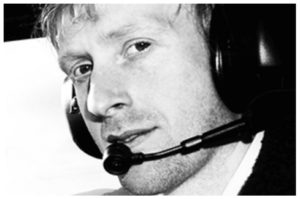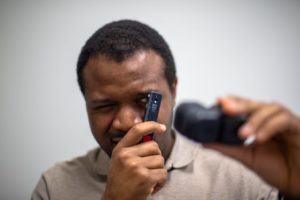A Shared Vision

Researcher Profile: William J Williams and The Arclight Team Making an Impact Through Innovation
Joseph Ogunjobi works with the University of St Andrews’ School of Medicine’s Communications team and interviewed William J Williams as he joined the School of Medicine in full capacity. While prior to the interview, Joseph was looking forward to chatting with the inventor about his work on the Arclight, he would go on to discover that there is such a long history and team of dedicated and passionate people driving the Arclight project forward. He explains below:
When I spoke with William J Williams, designer of the Arclight, he was in his element, sitting in his study at his home in Liverpool, surrounded by books and prototypes of medical devices. An optometrist, William became an Honorary Research Fellow at the University of St Andrews’ School of Medicine in 2017, later joining the School in full capacity in 2021, while continuing his private and NHS work.
The devices designed by William are easy to use but robust and appropriate for the need of the worker. The most recognizable of them, the Arclight is roughly the size of a marker pen. Powered by solar and USB and equipped with an LED bulb, its frugal design eliminates the need to charge batteries or for frequent changing of bulbs. The very first Arclight prototype was made from an ice lolly stick in 2008 and tested on a range of subjects including a cat, dog, child, a middle-aged person, and a pensioner. William has since gone on to design other medical devices such as the highly realistic SIMulation Eye and Ear, the Wilson, an illuminated magnifier for ‘front of the eye’ use, and the Holo, a Binocular Indirect Ophthalmoscope which is currently is currently undergoing trials.
William only spoke of his accomplishments in a modest tone. Happiest working in the background, he highlighted the contributions of ophthalmologists John Sandford-Smith who worked in Africa for 50 years, now retired, Richard Le Mesurier and Andrew Blaikie, all of whom saw the bigger picture of expanding distribution globally, particularly in low-income countries where the high cost of traditional ophthalmoscopes made it hard for doctors and students to have access to one.
One of the laudable aspects of the Arclight project is that as a social enterprise, the devices are sold at a higher price in wealthier countries. Generated profit is then turned back into the project to keep distribution at a subsidized cost to users in lower-income countries.
I wanted to learn more about the progress made on the Arclight project and Fiona Patterson, the Arclight Project Manager was very willing to share. She explained that the Arclight team is constantly improving the capabilities and functionalities of the existing devices, collaborating with other university departments, NGOs, medical practitioners and hospitals, Ministries of Health and other relevant stakeholders.
An example of such collaborations is with the School of Physics and Astronomy at the University of St. Andrews, where a team is working on a pilot study to develop a laser that will be attached to the Holo and will assist in treating diagnosed conditions. Other new improvements and features include the addition of a QR code on the Arclight, which when scanned through a mobile phone camera leads to the Arclight website containing relevant training materials and videos.
Speaking on support and collaboration, Fiona highlighted the efforts of the “Sir James Mackenzie Institute for Early Diagnosis” or the “Mackenzie Institute” for short. The Mackenzie Institute is a cross-university, multi-school initiative that includes as one of its four streams of research, digital diagnostics. The Institute focuses on research for the early diagnosis of diseases, and the Arclight fits nicely into its scope. Peter Donnelly, Professor of Public Health Medicine at the University of St Andrews, currently serves as Director of the Institute. He gave glowing commendations of William’s work and contribution to the project, describing the “inventive creativity and practical can-do attitude which has seen him work through many prototypes, guided by key philosophies of frugal engineering and continuous product improvement”. Peter shared that William’s inventiveness extends beyond Arclight with new Mackenzie relevant ideas currently being progressed. “William personifies the cross-disciplinary approach of the Mackenzie Institute, and the work that he and Andrew Blaikie are undertaking as a team is making affordable early diagnosis of serious eye conditions in the developing world an affordable reality” he added.
In my conversation with Peter, Andrew Blaikie’s name had come up again as it did with William and Fiona, I knew it was time for me to meet him. At the time, Andrew was away in Malawi, leading a training programme that will extend to about 1,300 Health Surveillance Assistants across the nation.
Andrew Blaikie is a consultant ophthalmologist with the NHS Fife and a senior lecturer at the University of St Andrews. He has been integral to the success of the Arclight projects, working on getting the devices to workers in lower resource countries with the aim of reducing the burden of disability. Even as we had our conversation over a video conferencing software at the earliest time his busy schedule would permit, Andrew stood leaning across his desk, resting on one foot and then the other as he spoke passionately about his work across Africa. William had described him not only as the academic brain behind the project but also as one of the main partners doing all the “legwork”, so this energy was unsurprising.
During our lengthy chat, Andrew spoke of the work being done on the sale and distribution of the devices, as well as training and collaboration with NGOs and other organizations, including the Christian Blind Mission, Rotary, SENSE International, Know the Glow, the German Committee for Blindness, the London School of Hygiene and Tropical Medicine, Universities in Malawi, Kenya, Tanzania and Uganda as well as government ministries in Africa, India and Mexico, hospitals, doctors, trainers and students. He explained that despite setbacks brought about by the pandemic, they have been able to resume physical training again. Andrew’s schedule for the rest of the year includes workshops in Kenya, Tanzania and Zimbabwe, with the aim of training more medical practitioners and students. In 2023, the team hopes to expand training and distribution in Asia and the Americas as well as engage with more of the major eye care NGOs such as Sightsavers and the Fred Hollows Foundation.
Despite William’s heads-up informing me of Andrew’s exceptional ability to stay motivated, I could not help but wonder from where he drew the strength to do it all. I asked. “I love the sense of bringing something valuable and different, the positive impact and change” he quipped. “And I just love people, the interaction, positive, friendly, happy nature of it all”. I had my answer.
One of the people who work closely with Andrew is Gatera Fiston Kitema, a PhD student researching the impact of interprofessional education in ophthalmology, using the Arclight as a primary tool. Fiston spends most of his time in Rwanda collecting data on the impact of the Arclight and training students and healthcare workers. He met Andrew at a clinical conference in Uganda in 2017 and was immediately fascinated by the Arclight. “It’s amazing to see students using the Arclight in their exams”, he said, describing how the device has changed the way students learn. He hopes that his research will yield positive results that will be adopted widely and help in the device being integrated into ophthalmology training. This, he believes, will lead to an increase in collaboration amongst healthcare workers in relation to eye health delivery in different settings in Rwanda.
I also spoke with Frank Maliko who works on an Inclusive Eye Health project with Nkhoma Mission Hospital in the central region of Malawi. One of the tools the hospital uses is the Arclight which helps workers such as nurses and clinic officers diagnose cases of cataracts. “The Arclight has transformed the way we work and train, from doctors to surveillance assistants working with the communities in case identification” he told me.
Looking forward, Andrew emphasised the need to develop strong educational packages around the tools, such as posters, information cards, and instructional videos, which will allow strong and effective implementation of the devices. The goal is for other NGOs and Ministries of Health to easily adopt the devices in their countries. The wider team is also working on developing simulation tools in the form of mobile applications on smartphones and sharing educational videos online. These measures will have positive and long lasting effects on the quality of eye care and help in reducing visual impairments and needless blindness.
William shared similar thoughts and explained that the project so far has only scratched the surface of what is possible. “If you take India for example there are millions of GPs, doctors and medical practitioners who will find these devices useful”.
On production of new devices, William revealed that the Holo is almost ready for distribution. “We look at the devices in a sort of a pyramid structure”, he explained. The simple devices are at the bottom and will be distributed en masse, then there are the mid-level devices such as the Arclight ophthalmoscope and at the top, the specialist devices such as the Holo, which will only be used by a small number of people.
He, however, had a word of caution. “It is very easy to come up with ideas and prototypes, the tough stuff is getting it done” explaining that the priority for the immediate future will be to focus on the production of the devices.
Andrew believes juggling the different aspects of the work and different projects can be difficult but enjoys the challenge. He admits it has been harder to penetrate countries where the project team commands limited networking reach but sees clear progress being made. In Nigeria, Africa’s most populous nation, Arclight distribution has historically stayed relatively low, but Fiona explained that the team has seen requests from the West African nation, come through The International Agency for the Prevention of Blindness (IAPB). Andrew also hinted at a collaboration with a group based in Lagos, Nigeria’s largest state by population and economic activity, and is confident more headway will be made in the country in 2023.
Back in Liverpool where I joined William via video call, I was appreciative of him taking time out of his busy schedule to talk to me, and he reassured me that he was always available to chat. Despite the global impact the Arclight project has had, the inventor was mindful in acknowledging its personal significance, saying that his work on this project and its relevance to the medical field keeps him “grounded in the real world”. He rose from his desk to let an impetuous cat out into the garden via a door through which the morning light had been beaming. I chuckled as I wondered if this cat would one day be the first test subject of another of William’s ground-breaking inventions.
